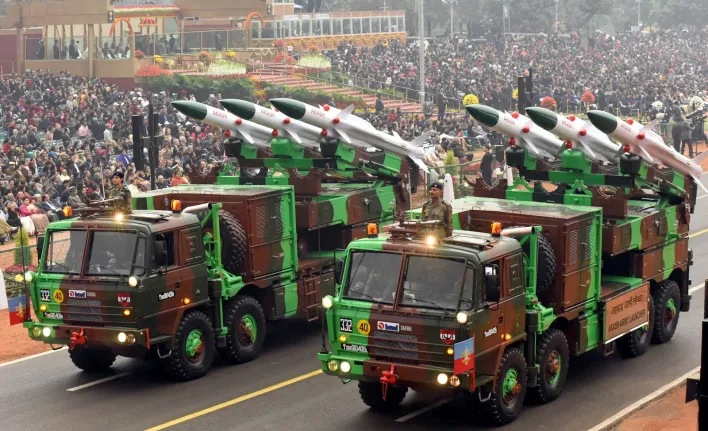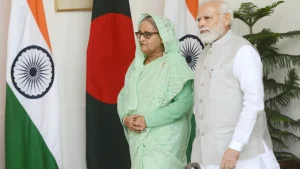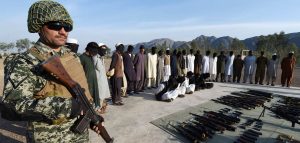India’s Defence Minister Rajnath Singh, on August 23, 2025, revealed a new defensive shield known as the Integrated Air Defence Weapon System (IADWS). It is a multi-layered air defence system comprising indigenously developed Quick Reaction Surface-to-Air Missiles (QRSAM), Advanced Very Short-Range Air Defence System (VSHORADS) missiles, and a high-power laser-based directed energy weapon (DEW). The latest endeavour is part of India’s ambitious project, ‘Sudarshan Chakra, that Prime Minister Narendra Modi announced on August 16, which aims to build a defensive shield guarding the Indian airspace from all types of airborne threats. However, building such a shield will destabilize the region, increasing incentives for New Delhi to strike its opponent pre-emptively, assuming that the retaliatory response could be curtailed.
The IADWS is developed by India’s indigenous weapons industry and is equipped with kinetic and non-kinetic systems. All three sub-units working under IADWS are meant to provide an air defence shield to both static and moving targets. QRSAM will provide short-to-medium range coverage, while VSHORADS and DEW will act as the last line of defence. Previously, all three systems were independently tested on various occasions. However, their maiden test working simultaneously in a real-time scenario was conducted on August 23, during which all airborne targets were successfully neutralized. Let’s break down the sub-units of IADWS one by one.
QRSAM is the backbone of IADWS. It is developed to protect the Indian Army’s advancing mechanized formations. It is based on mobile platforms, which provide air defence to units while moving. However, it can also offer air defence coverage to static military installations, ranging from air bases to ammunition depots. QRSAM can neutralize aerial objects to a distance of approximately 30 km, flying at an altitude of 14 km . One regiment has three batteries, which are further divided into four combat groups (CGs) each. Each group has around four missile launchers, one capable of holding and firing six surface-to-air interceptors. So, one regiment of QRSAM has 72 ready-to-fire interceptors at its disposal. The system has a 120 km range primary active phased-array surveillance radar for detection and another 80 km range radar for tracking 10 targets in real-time. In the initial phase, three regiments are expected to be inducted into the Indian Army’s air defence command, followed by more units in the future.
VSHORADS is a domestically manufactured surface-to-air missile (SAM) system that neutralizes various aerial threats, including fixed and rotary-wing manned and unmanned airborne systems at lower altitudes. The system has two versions: a man-portable and a vehicle-mounted version. It can engage targets at a maximum altitude of around 3 km , and the horizontal interception range is limited to 6 km only. The missile is guided by an infrared seeker , which allows it to home in on the heat signature generated by an aircraft. The system is built to operate across all terrains from Siachen in the north to Jamnagar in the South. All the tri-services of the Indian armed forces will soon induct this system.
The domestic build DEW system, powered by a 30-kW laser-based weapon system, was first tested by India in April this year. The system can shoot down any airborne threat within a radius of 5 km . It has a 360-degree censor, which can look for threats across all domains. The version tested by India for IAWDS was similar to this one. However, India is also developing a 300-kW system with a targeting range of 20 km, dubbed “Surya”. These DEW systems in development are designed to take out loitering munitions and swarm drones, thus easing the burden on other systems designed to neutralize aerial objects at the terminal stage. They are also less costly than other air defence systems, reduce collateral damage, and can quickly destroy multiple threats.
IADWS is part of broader efforts undertaken by the present Indian administration to establish an impenetrable invisible air defence shield. It will act as the sub-layer of the Sudarshan Chakra shield. However, this is not a new ambition but a continuity of the previous efforts under which the Indian Ballistic Missile Defence (BMD) program was initiated. The details are scarce because the Sudarshan Chakra project was announced very recently, and some light has been shed on this venture by the Indian Chief of Defence Staff (CDS) General Anil Chauhan. According to him, under the Sudarshan Chakra project, India will construct an infrastructure and lay out ground rules to ease the detection, tracking, and engagement of unidentified airborne projectiles by employing hard and soft kill methods.
The idea of building such a system, which is designed to block and destroy all incoming airborne objects, will enhance India’s capability to neutralize the adversary’s strike. This will reinforce India’s belief that it can go for launching pre-emptive strikes against Pakistan and then absorb Pakistan’s retaliatory response. This ends the condition of mutual vulnerability or Mutual Assured Destruction (MAD), which makes the eruption of conflict and wars more likely and at frequent intervals. All of this goes against the notion of strategic stability, which argues in favour of no side having the incentive to strike first in a crisis. However, India’s new initiative will likely decrease stability in South Asia, where the situation is already fragile due to New Delhi’s belligerent behaviour, as evident from its action in May 2025.
Conclusively, IADWS’s defensive shield may augment India’s ability to shoot down incoming rockets, missiles, and drones; however, working under the ambit of the Sudarshan Chakra Initiative, it will likely reinforce India’s illusion of invulnerability, pushing it further toward adoption of a counterforce posture, which automatically increases preemptive temptations. A shield that breeds overconfidence makes South Asian future crises more dangerous.
















